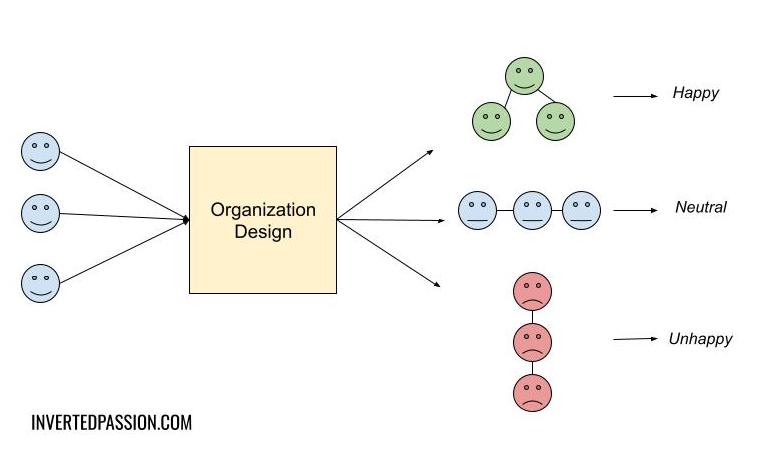Right from the start, an entrepreneur should constantly be thinking about what arrangement of people is most suitable for delivering the goals of the company and what arrangement may be required about a year after. No one else would do this thinking. No employee will come and say fire me and hire a specialist instead. Only an entrepreneur would need to take this call proactively.

Organization design is simply what roles should be there in the company and how those roles should be related to each other. Many entrepreneurs and CEOs follow industry norms in hiring, and so their organization chart takes a standard shape that’s indistinguishable from their competitors.
That’s inefficient because each company has an essentially unique strategy and hence deserves a unique organization design that implements that strategy effectively.
In some cases, org design happens by accident because there’s no well-thought growth strategy. A prerequisite for doing org design is clarity on strategy because if there’s no clarity, then whatever org chart you have will automatically start determining what your strategy.
To be a good organization designer, you have to be a good psychologist. You have to first learn what conditions bring out stellar performances in individuals, and then design a structure where people can find themselves in such conditions.
Common mistakes that entrepreneurs end up making while designing their org:
- Underinvesting in specialist roles. It’s true that you don’t realize how much better a job can be done until you’ve seen someone do it 10x better. This means that for every role in your company, there are people who can do parts or the entirety of it 10x better than existing people. You don’t need a good marketer, what you need is someone who’s killer at search engine advertising when it comes to your industry. You don’t need a frontend engineer, what you need is a frontend performance engineer who can speed up your app 10x and hence considerably impact user satisfaction. If there’s a job worth doing well (from the perspective of your strategy), hire a specialist.
- Having quality functions report into quantity functions. Functions such as QA and development should always be parallel in org chart and not report to one another. If you report quality oriented functions into quantity oriented ones, quality will suffer. If you report quantity into quality, speed will suffer.
- Having long-term initiatives report into people accountable for short term. This is the reason big organizations often cannot innovate when it comes to completely new initiatives. For people who’re tasked with short-term targets, long-term initiatives are a distraction because at the start they’re simply too small or too risky to get meaningful attention or resources. Since such people’s performance is measured on short-term targets, the big and the scaled up is where their interest goes. This lack of early nurturing causes long-term initiatives to fail early, creating a vicious cycle of stagnation. To solve this, long-term initiatives (such as strategy, R&D lab or brand building) need to be put into a separate place in the org chart (perhaps under a leader who reports directly to the entrepreneur/CEO).
- Not eliminating outdated roles and functions fast enough. The org chart should change as the strategy of the organization changes, which happens automatically as the company grows. Org chart implements the strategy, so not changing it frequently means your company will keep attempting to grow via the old ways. So one of the jobs of the entrepreneur/CEO and the board is to frequently assess if the org chart is aligned to strategy.
- Promoting high performers to be managers and leaders. This is super-hard to avoid in reality, but when individual contributors who’re star performers get promoted, the organization gets damaged twice: one, the person who does the specialist job well isn’t there to perform it, second, now you have a manager who is probably a mediocre one (when you could have gotten an experienced manager). If you promote your best performers to managers, ultimately your org will be full of mediocre managers. Too often, org charts revolve around the availability of people (and the fear of losing high performers). The right way, however, is to be clear of what roles exist in the org chart and what types of people will perform those roles best. Don’t fit roles into people, fit people into roles.
You will lose your best performers as your company grows because their roles will become redundant as your strategy evolves. Typically, your company’s entire leadership team has to be changed 3-4 times before it becomes big (say, >$100mn).
Remember: organization design should be a deliberate exercise, as it is what’ll determine if your strategy gets executed well or not. Most roles in history didn’t exist until someone thought of it. So if you have to invent a role, you should.
This essay is part of my book on mental models for startup founders.
Join 200k followers
Follow @paraschopra